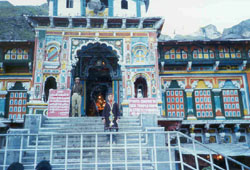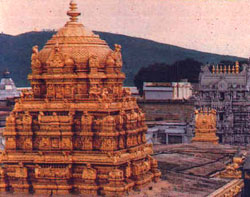|
 History
of patronage: These shrines have been held in
reverence for centuries. In Tamilnadu where 84
of these shrines are situated, the Pallava rulers (as
in Mahabalipuram, Nandipuravinnagaram),
and the Chola emperors (10th through the 13th centuries) provided
for the construction (in stone), expansion and upkeep
of these shrines through generous endowments. The Pandyas
who followed continued this tradition. It was under the rule
of the Vijayanagar emperors that shrines such as Srirangam,
Tirukkachhi and Tirupati
received the greatest extent of royal patronage. The Nayaka
rulers of Madurai continued this glorious tradition after
the Vijayanagar rulers. History
of patronage: These shrines have been held in
reverence for centuries. In Tamilnadu where 84
of these shrines are situated, the Pallava rulers (as
in Mahabalipuram, Nandipuravinnagaram),
and the Chola emperors (10th through the 13th centuries) provided
for the construction (in stone), expansion and upkeep
of these shrines through generous endowments. The Pandyas
who followed continued this tradition. It was under the rule
of the Vijayanagar emperors that shrines such as Srirangam,
Tirukkachhi and Tirupati
received the greatest extent of royal patronage. The Nayaka
rulers of Madurai continued this glorious tradition after
the Vijayanagar rulers.
The
shrines: 47 of the 108 Divya Desams have been
addressed only by Tirumangaialwar and 18 only by Nammalwar.
While 2 are addressed only by Tirumazhisaialwar, 1 by Kulasekharalwar
and 1 by Perialwar, the remaining 39 are addressed by hymns
composed by more than one of the saints. In combination with
the other saints, Tirumangaialwar has addressed 83 of the
108 Divya Desams and Nammalwar 35. While 247 verses
are addressed to Srirangam - 202 are addressed to Tirupati,
128 to Azhagar Koyil and only 7 to Kanchipuram (Tirukkachhi
Attigiri). The celestial abodes Tirupparkadal (The Milky Ocean)
and Paramapadam (Vaikuntham) get 51 and 36 verses each.
Geographic distribution: 40
of the shrines are located in the fertile Chola kingdom and
22 are in Tondainaadu - around Kanchipuram and Chennai. 2
are in Nadu Naadu (Tiruvahindrapuram and Tirukkovilur) and
18 are in Pandyanaadu. 13 of the shrines are in Malainaadu,
of which 11 are in Kerala and 2 are in Kanyakumari district;
therefore the total number of Divya Desams in Tamilnadu is
84. 11 Divyadesams are in Vada Naadu, or the northern lands
- of which two, Tirupati and Ahobilam
are in Andhra Pradesh. 7 of these 11 are in Uttar Pradesh
(such as Mathura, Ayodhya,
Badrinath etc.)., 1 in Nepal and 1 in Gujarat.
Two of the Divyadesams - Ksheerasaagaram
and Vaikuntham are celestial abodes.
 Thus,
106 temples have been addressed by the Tamil Alwars, who were
pillars of the Sri Vaishnava tradition that was to evolve
in Tamilnadu. The contrast in the nature of these temples
is stunning, given the diversity in the Indian subcontinent.
Even a virtual visit to these 106 shrines
across the nation, is quite an experience, and is illustrative
of this contrast, given the difference in the nature of temples
in the various regions such as the Kaveri basin, Andhra
Pradesh, Kerala, the Tirunelveli region, the Gangetic plains
and the Himalayas. Thus,
106 temples have been addressed by the Tamil Alwars, who were
pillars of the Sri Vaishnava tradition that was to evolve
in Tamilnadu. The contrast in the nature of these temples
is stunning, given the diversity in the Indian subcontinent.
Even a virtual visit to these 106 shrines
across the nation, is quite an experience, and is illustrative
of this contrast, given the difference in the nature of temples
in the various regions such as the Kaveri basin, Andhra
Pradesh, Kerala, the Tirunelveli region, the Gangetic plains
and the Himalayas.
State
of these temples: Some of the Divya Desam shrines
are grand monuments such as the Ranganathar
Temple at Srirangam, Naachiyaar temple at
Srivilliputtur, the Padmanabhaswamy temple
at Tiruvanandapuram and the Varadaraja Perumaal
temple at Kanchipuram, visited by thousands.
Badrinath, the northernmost of the Divyadesams
is a shrine venerated throughout India. Tirupati
(Tirumala) is the most visited of these 108 Divya Desams,
and is held in great regard by pilgrims all over the country.
Tiruvallikkeni a well visited shrine and
a prominent landmarks in the modern city of Chennai, attracts
thousands of devotees during the Vaikuntha Ekadasi festival
in the month of Margazhi. Ranganathar
Temple at Srirangam, Naachiyaar temple at
Srivilliputtur, the Padmanabhaswamy temple
at Tiruvanandapuram and the Varadaraja Perumaal
temple at Kanchipuram, visited by thousands.
Badrinath, the northernmost of the Divyadesams
is a shrine venerated throughout India. Tirupati
(Tirumala) is the most visited of these 108 Divya Desams,
and is held in great regard by pilgrims all over the country.
Tiruvallikkeni a well visited shrine and
a prominent landmarks in the modern city of Chennai, attracts
thousands of devotees during the Vaikuntha Ekadasi festival
in the month of Margazhi.
Some of the Divya Desams in Tamilnadu, stand as grand
monuments gracefully located away from the beaten track (Tirukkovilur,
Sri Vaikuntham for example). Three of the
Divya Desams are sub shrines in the prakarams of other Divya
Desams. The Tiruoorakam (Ulagalanda Perumaal
Koyil) houses the Divyadesams Oorakam, Neerakam,
Kaarakam and Kaarvaanam. Two
of the Divyadesams are subshrines in other temples. Nilattingal
Tundam is a shrine to Vishnu in the inner prakaram
of the grand Ekambreswarar temple at Kanchipuram,
while Kalvanoor is a shrine to Vishnu in
the Kamakshiamman temple at Kanchipuram.Tiruchitrakootam,
is located within the grand Nataraja temple complex
at Chidambaram.
Iconography:
While in Saivite shrines, it is the Shivalingam or
the non-anthropomorphic form that is enshrined in the
innermost sanctum, it is the iconic form of Vishnu that is
center of reverence in the 106 Divya Desams. Vishnu is represented
usually in one of three postures - reclining (Sayanam
or kidanda kolam) as in Kumbhakonam,
seated posture (irunda kolam) as in Tirupperai,
or standing (ninra kolam) as in Tirupati
(Tirumala).
Worship
protocol: While in all of the Divya Desams in
Tamilnadu (with the exception of Nilattingal Tundam,
Kalvanoor, Tiruvaattaru
and Tiruvanpatisaaram) the Vaishnava Agamic
(Pancharatra or Vaikanasa) protocol of worship is followed,
the Kerala Tantram is followed in the Divyadesams in Malainadu.
Worship services at Badrinath follow a protocol
established during the period of Adi Sankaracharya.
Festivals:
Most of the Divya Desams in Tamilnadu follow an elaborate
tradition of festivals. The Margazhi festival, involving the
recital of the Alwar hymns - and the climax of the festival
on the day of Vaikuntha Ekadasi are traditions which have
sustained for several centuries, enriching the cultural life
of the tamil region. The annual festival at the Kallazhagar
temple in the month of Chittirai, coinciding with
the Bhramotsavam at the Madurai Meenakshi Sundareswarar
temple imparts a festive look to the entire region, drawing
hundreds of thousands of visitors from all over the state.
The
Saivite Nayanmars lived roughly during the same
period as the Alwars. While Karaikkal Ammaiyaar and Tirumoolar
lived in the first half of the first millennium CE (the first
of the Alwars are said to belong to the same period), Appar
and Sambandar the foremost of the Tevaram saints lived in
the 7th century. (Tirumangaialwar belonged to the 9th century
while ) Sundaramurthy Nayanar lived in the 9th century CE.
The Tevaram hymns were rescued from obscurity
and set to music by Nambiandar Nambi during the rule of Rajaraja
Chola I, roughly during the same period in which the Alwar
Paasurams were compiled by Nadamuni. 275 Shiva temples in
the Indian subcontinent have been glorified with at least
a decad of 10 Tevaram verses (patikam) each of the Nayanmars
(275 Tevara Paadal Petra Stalams), while 249 (others) have
been addressed (referred to) by the Tevaram (249 Tevara Vaipputtalams).
Templenet
is proud to feature the 108 shrines and celestial Abodes of
Vishnu revered by the tamil hymns of the Alwar saints.
108
Divya Desams
|

